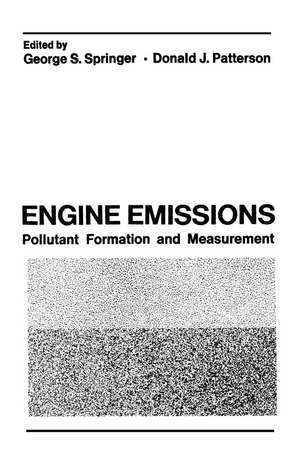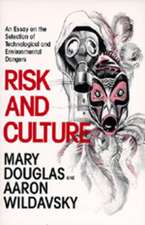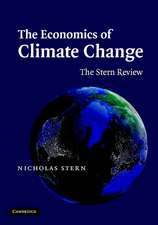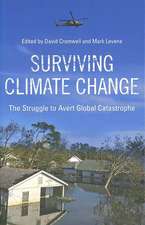Engine Emissions: Pollutant Formation and Measurement
Editat de George Springeren Limba Engleză Paperback – 22 mar 2012
Preț: 643.99 lei
Preț vechi: 757.63 lei
-15% Nou
Puncte Express: 966
Preț estimativ în valută:
123.24€ • 127.32$ • 102.57£
123.24€ • 127.32$ • 102.57£
Carte tipărită la comandă
Livrare economică 25 martie-08 aprilie
Preluare comenzi: 021 569.72.76
Specificații
ISBN-13: 9781468419856
ISBN-10: 1468419854
Pagini: 388
Ilustrații: XII, 372 p.
Dimensiuni: 152 x 229 x 20 mm
Greutate: 0.52 kg
Ediția:Softcover reprint of the original 1st ed. 1973
Editura: Springer Us
Colecția Springer
Locul publicării:New York, NY, United States
ISBN-10: 1468419854
Pagini: 388
Ilustrații: XII, 372 p.
Dimensiuni: 152 x 229 x 20 mm
Greutate: 0.52 kg
Ediția:Softcover reprint of the original 1st ed. 1973
Editura: Springer Us
Colecția Springer
Locul publicării:New York, NY, United States
Public țintă
ResearchCuprins
1. Engine Exhaust Emissions.- I. Introduction.- II. When Is an Emittant a Pollutant?.- III. Formation of Pollutants.- IV. Transient Operation — Engines.- V. Transient Operation — System.- VI. Evaluation of Vehicle Emissions.- VII. Control Techniques.- References.- 2. The Chemistry of Spark-Ignition Engine Combustion and Emission Formation.- I. Introduction.- II. Engine Processes.- III. Ultimate Fate of Engine Emissions.- IV. The Engine—A Chemical Reactor.- V. The Combustion Chamber.- VI. Exhaust System.- VII. Systems Approach to Reactions in an Engine.- VIII. Summary.- References.- 3. Mechanism of Hydrocarbon Formation in Combustion Processes.- I. Introduction.- II. Ignition Delays in Low Molecular Weight Hydrocarbon-Oxydizer Systems.- III. Production and Emission of Unburned Hydrocarbons.- IV. Some Effects of Hydrocarbon Emissions on Man and His Environment.- References.- 4. The Kinetics of Pollutant Formation in Spark-Ignition Engines.- I. Introduction.- II. Chemical Thermodynamics of the Engine Cycle.- III. Combustion of Hydrocarbon Fuel-Air Mixtures and the Approach to the Initial High-Temperature Equilibrium State.- IV. Formation of Nitric Oxide.- V. Expansion and Exhaust Processes.- VI. The Effect of Pressure Oscillations on Nitric Oxide Kinetics.- 5. Particulate Emission from Spark-Ignition Engines.- I. Introduction.- II. Measurement Techniques.- III. Physical Characteristics of Particulates.- IV. Chemical Composition of Particulates.- V. Concluding Remarks.- References.- 6. Diesel Engines Combustion and Emissions.- I. Introduction.- II. Diesel Ignition and Combustion.- III. Direct-Injection Engines.- IV. The M-System.- V. Indirect Injection Engines.- VI. Comparison Between the Emission Characteristics of Some Transportation Engines.- VII. NO EmissionControl.- VIII. Concluding Remarks.- References.- 7. Diffusion and Fallout of Pollutants Emitted by Aircraft Engines.- I. Introduction.- II. Identification of Sources.- III. Diffusion and Fallout.- IV. Chemical and Physical Conversions.- V. Plume Axis from a Stack.- VI. Plume Paths from Aircraft.- VII. Wing-Tip Vortices.- VIII. Plume Visibility.- IX. Concluding Remarks.- Notation.- References.- 8. Instrumentation and Techniques for Measuring Emissions.- I. Methods for Measuring Pollutants.- II. Automotive Emissions Measurement.- III. Measurement of Emissions from Diesel and Turbine Engines.- References.- 9. Direct-Sampling Studies of Combustion Processes.- I. Introduction.- II. A Simplified Model of Molecular-Beam Sampling.- III. Boundary-Layer Considerations.- IV. Chemical Relaxations.- V. Species Condensations.- VI. Skimmer Interference.- VII. Mass Separations.- VIII. Background Scattering.- IX. Mass-Spectra Interpretations.- X. Preliminary Applications.- References.










